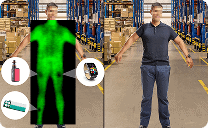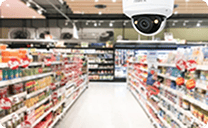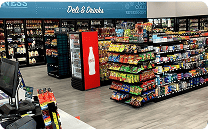In This article
A Fisheye camera is designed to provide a broad visual field using a specialized (fisheye) lens that bends light and distorts perspective to include as much of the surrounding area as possible. Unlike traditional surveillance cameras, which focus on narrow or fixed zones, fisheye cameras capture ultra-wide-angle images covering large spaces from a single mounting point.
Typically installed on ceilings, walls, or high vantage points, fisheye cameras allow businesses to monitor activity in multiple directions without needing several individual cameras. This makes them popular for locations prioritizing comprehensive visibility and minimal hardware.
The main characteristic of a fisheye camera is its curved, hemispherical lens, which produces a circular or panoramic image. Software processes this view to dewarp or flatten the footage into more usable perspectives for monitoring and review.
How Fisheye Cameras Work
Fisheye cameras use ultra-wide-angle lenses that typically offer 180- to 360-degree horizontal coverage. Because light is captured and bent, the raw output footage often appears rounded or distorted. However, video management software or in-camera processing tools can correct this distortion through a process known as de-warping.
Dewarping creates multiple flat viewing angles from the original image, allowing operators to focus on specific zones, track movement, or zoom in on areas of interest—all from a single camera.
Some fisheye cameras also support multi-streaming, providing different viewing angles simultaneously for live monitoring or recorded playback.
Common Applications of Fisheye Cameras
Fisheye cameras are beneficial in spaces where visibility in all directions is essential, and installing multiple cameras would be costly or impractical. Typical applications include:
- Retail stores: Monitoring customer flow, checkout areas, entrances, and sales floors from a single ceiling-mounted unit.
- Warehouses and industrial spaces: Providing a bird’s-eye view of workstations, storage areas, restricted areas, and safety zones.
- Restaurants: Monitoring dining areas, kitchen prep areas, store rooms, drive-thrus, and parking lots.
- Hospitality and entertainment venues: Overseeing lobbies, dining rooms, or event spaces without disrupting aesthetics.
- Parking garages: Tracking vehicles and foot traffic across large, open areas.
- Corporate offices: Keeping an eye on shared spaces such as break rooms or reception areas.
Fisheye cameras are often paired with analytics software to enhance monitoring, detect motion, or alert teams to abnormal behaviors within the camera’s wide field of view.
Benefits and Considerations
Fisheye cameras offer several advantages:
- Wide-area coverage from a single device, reducing hardware and installation costs.
- 360-degree or panoramic visibility for full-scene awareness.
- Fewer blind spots, improving security and monitoring accuracy.
- Reduced infrastructure, with less need for multiple cameras or complex wiring.
- Dewarping technology that allows focused views without losing context.
However, fisheye cameras also have some limitations. Due to lens distortion, image resolution may decrease toward the edges of the field of view. Additionally, fisheye cameras are not ideal for identifying fine details like facial features or small text, especially when zoomed out across large areas.
Positioning is also critical—an incorrect installation height or angle can reduce effectiveness or create visual blind spots in key zones.
See the Full Picture with DTiQ
The DTiQ 360iQ platform supports wide-angle and fisheye camera solutions that deliver complete visibility of your business environment. VIDEOiQ can integrate 360-degree coverage with intelligent video analytics and centralized monitoring. DTiQ helps you capture more of what matters, without adding complexity. Whether you’re watching a sales floor or a warehouse, DTiQ turns panoramic vision into powerful insights. Contact us to learn more.




























